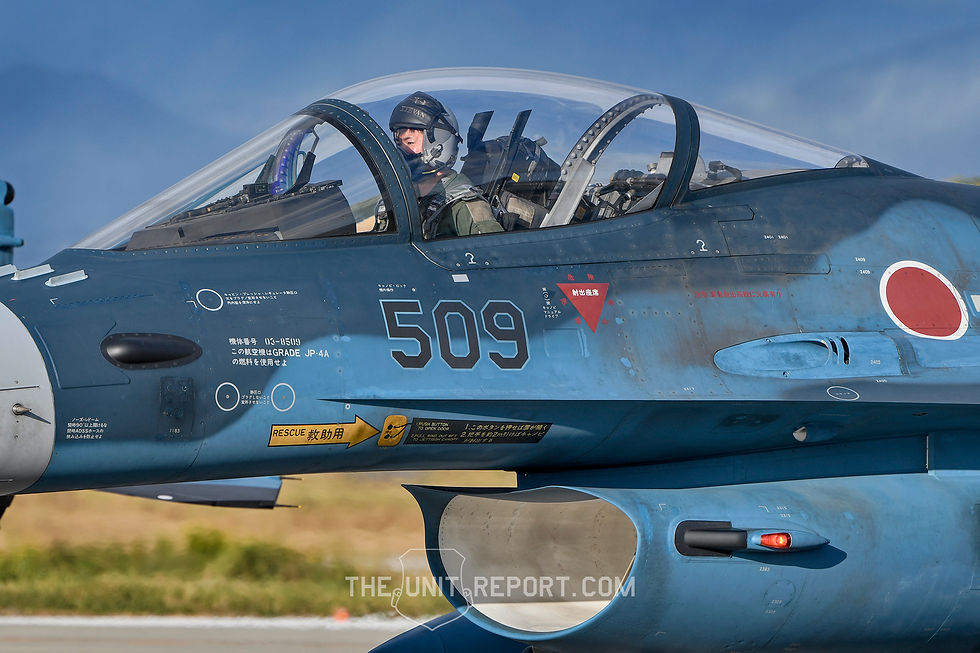Tsuiki Air Festival 2024
- Robin Polderman
- Dec 26, 2024
- 4 min read
Updated: Jan 9

Report and photos by Robin Polderman
In order to immerse ourselves fully in the Japanese airshow culture, The Unit Report traveled to the southern island of Kyushu, to see what the Tsuiki Air Festival is all about.

Those contemplating a visit to the Tsuiki airshow should arrive on time. No car parking is available on the base. Visitors have to park at various designated areas in the vicinity and take a shuttle bus or arrive by train. At 06:15 in the morning, when approaching one of the car parks located on a baseball field in the vicinity of the base, we were greeted by a huge row of vehicles awaiting the facility's opening. Some of the aviation aficionados clearly stayed in their vehicles overnight in order to secure the best available spots at the venue. As is common with everything in Japan, queueing is done orderly and efficiently, and when buses are scheduled to leave at 7 o’clock, they leave exactly on time.

Before the showground opened to the public, at 8 AM sharp on Sunday 24 November, the based Mitsubishi F-2 fighters were already heard taking off. The two squadrons that call Tsuiki home, the 6th and 8th Hikotai, launched eighteen jets in quick succession for the show opening.
A sixteen-jet fly-by was followed by a formation of jets forming the numeral ‘70’ in the air, marking the 70th anniversary of JASDF Tsuiki airbase. In reality, the airfield was opened in 1942 to serve the needs of Imperial Japan and its armed forces. During the Korean War, in the early fifties, the USAF used the base to perform maintenance on F-86 Sabres.
In the course of 1955, the Japanese Air Self Defense Force (JASDF) based some of its brand-new T-33 jet trainers at Tsuiki, and it has been an active JASDF airbase ever since. Following the T-33, the F-86, Mitsubishi F-1, F-4EJ, and F-15J/DJ were operated from Tsuiki over the years. The base now houses two squadrons of F-2 fighters and a handful of Kawasaki T-4 hacks.

After we arrived at the showground, we noticed the crowd was positioned right at the edge of the flight line to be able to immerse in all the action taking place there. Following the morning launch, all jets recovered and were parked in front of the public. This all takes place before the clock strikes 9 AM!
During the morning and early afternoon, the public was treated to four more waves of F-2 jets, although these waves were smaller than the ones in the early morning. A pair of jets carrying special markings on the tail would take to the air twice. In the early summer of 2024, the Tsuiki Airbase hosted a competition on the base’s website to attract designs for a special ’70 years Tsuiki Airbase’ tail. The fact that Tsuiki’s anniversary coincides with the JASDF’s 70th anniversary provided a good reason to paint up not one but two jets. Two drawings were chosen from the many submitted proposals, and the designer's name is displayed proudly on the tail of the jet.

Besides loads of local F-2 fighters, a few more aircraft could be seen in the skies over Tsuiki. The Japanese Maritime Self Defense Force (JMSDF) sent two aircraft to the base for a single fly-by each. First up was the impressive Shin-Maywa US-2 flying boat followed by an U-36A Learjet which is used as a target tug. With retirement of the pair of remaining U-36 aircraft imminent, an appearance at the Air Festival was welcomed by many. The 305 Hikotai from Nyutabaru sent over one of its F-15 Eagle aircraft for a demonstration flight. It took off from Nyutabaru airbase and returned there after its performance.
Co-located at the island of Kyushu is the 13th Flying Training Wing operating the T-4. A flight of four came overhead, went into the break, and performed an individual fly-by. Luckily the unit had selected its specially painted 'JASDF 70th anniversary' machine to be part of the formation.

Static displays at Japanese airshows are usually a relatively small affair. At the Tsuiki Air Festival, the JASDF displayed a KC-767 tanker, a Gulfstream, a CH-47JA SAR Chinook, a C-2 transport as well as an F-15J and T-7 trainer. The JMSDF sent one of its P-1 maritime patrol aircraft from Kanoya airbase, arriving on the Sunday morning of the Festival at first light. This aircraft was also the first to go, as soon as the airshow ended. A welcome foreign visitor for the static display came from USMC Iwakuni; a UC-12W was parked near the crowd line for all to admire.

As is the case with most Japanese airshows, there is the opportunity to disconnect from aviation for a brief moment and indulge in excellent street food from the many stalls. For those wanting a souvenir, whether it’s a patch, towel, or key chain, there are ample opportunities to acquire these items. Shortly after 2 PM, the local security started sweeping the area near the flight line clear of visitors and those present were persuaded to proceed to the nearest shuttle bus stop.

For such a well-organized and entertaining airshow, the number of visitors was relatively low. Only 22000 people flocked to Tsuiki airbase this year, while the Festival in 2023 attracted 68000 souls. Mind you, the 2023 edition featured the JASDF demonstration team ‘Blue Impulse’ flying six T-4 jet trainers.
It is no secret that the Blue Impulse are hugely popular all over Japan, and any airshow with the team participating sees a huge uptick in visitors.
The Tsuiki Air Festival not only provided plenty of action but also the possibility to photograph F-2 operations on the flight line up close. Therefore earplugs and ample space on the memory card are a must.
In order to make the most of the day and catch all the action on offer: be early, be very early!

































